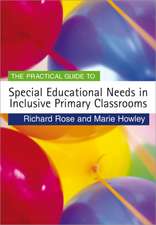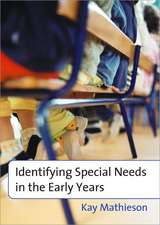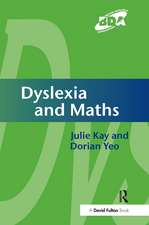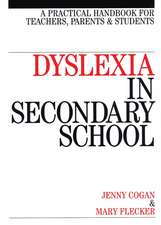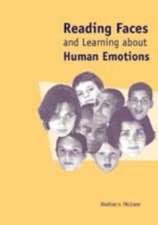How the Gifted Brain Learns
Editat de David A. Sousaen Limba Engleză Paperback – 7 oct 2009
This reader-friendly guide gives elementary and secondary teachers the help they need to not only recognize and challenge their gifted learners, but also to support gifted students who underachieve. Acknowledging that students are often gifted in specific subject areas, the text includes chapters dedicated to talents in language, math, and the arts. Special "From the Desk of a Teacher" sections offer classroom-tested examples of the instructional applications suggested by research. In addition to featuring new research and expanded curriculum ideas, this second edition helps answer questions about:
- How the brains of gifted students are different
- How to gauge if gifted students are being adequately challenged
- How to identify students who are both gifted and learning disabled
- How improving programmes for the gifted and talented benefits other students
- How to better identify gifted minority students, who are often underrepresented in gifted programmes
This resource is a one-stop shop of brain-compatible strategies for teaching the full range of gifted students!
Preț: 285.11 lei
Nou
Puncte Express: 428
Preț estimativ în valută:
54.55€ • 57.11$ • 45.14£
54.55€ • 57.11$ • 45.14£
Carte disponibilă
Livrare economică 15-29 martie
Livrare express 01-07 martie pentru 46.59 lei
Preluare comenzi: 021 569.72.76
Specificații
ISBN-13: 9781412971737
ISBN-10: 141297173X
Pagini: 296
Ilustrații: black & white tables, figures
Dimensiuni: 216 x 279 x 18 mm
Greutate: 0.82 kg
Ediția:Second Edition
Editura: SAGE Publications
Colecția Corwin
Locul publicării:Thousand Oaks, United States
ISBN-10: 141297173X
Pagini: 296
Ilustrații: black & white tables, figures
Dimensiuni: 216 x 279 x 18 mm
Greutate: 0.82 kg
Ediția:Second Edition
Editura: SAGE Publications
Colecția Corwin
Locul publicării:Thousand Oaks, United States
Recenzii
"A great book to use to assist preservice teachers, inservice teachers, and administrators with ways to meet the needs of all types of gifted learners."
"Each chapter offers the practitioner page after page of suggestions on how to apply the research discussed to educational practice. The applications sections are extremely intriguing and offer more than the traditional 'discovery learning' approach to teaching these remarkable children."
"I loved this book. It expands the reader’s definition of what it means to be gifted. Many schools focus only on academic giftedness, but this book has very practical ways to help students gifted in the arts utilize their talents. Sousa provides enough information to help someone who has never developed a gifted program before get started, and yet challenges the reader’s preconceived notions enough to help a school with a rich gifted program have discussions that will improve the existing program."
“Pulls many areas of gifted research, knowledge, and applications together in a clear and concise manner. This is a one-stop book for teachers who have high-ability/gifted students in a classroom and need to understand how these students’ brains work and how to plan effective instruction.”
"Brain research is changing the way teachers respond to student needs, and this book deals with the topic well. The biological descriptions of brain anatomy were simplified so that non-science educators could comprehend the research with the author’s ideas on implications. While the book is intended to focus on identifying and educating gifted and talented students, it also provides insights for instruction of all students."
"Each chapter offers the practitioner page after page of suggestions on how to apply the research discussed to educational practice. The applications sections are extremely intriguing and offer more than the traditional 'discovery learning' approach to teaching these remarkable children."
"I loved this book. It expands the reader’s definition of what it means to be gifted. Many schools focus only on academic giftedness, but this book has very practical ways to help students gifted in the arts utilize their talents. Sousa provides enough information to help someone who has never developed a gifted program before get started, and yet challenges the reader’s preconceived notions enough to help a school with a rich gifted program have discussions that will improve the existing program."
“Pulls many areas of gifted research, knowledge, and applications together in a clear and concise manner. This is a one-stop book for teachers who have high-ability/gifted students in a classroom and need to understand how these students’ brains work and how to plan effective instruction.”
"Brain research is changing the way teachers respond to student needs, and this book deals with the topic well. The biological descriptions of brain anatomy were simplified so that non-science educators could comprehend the research with the author’s ideas on implications. While the book is intended to focus on identifying and educating gifted and talented students, it also provides insights for instruction of all students."
Cuprins
About the Author
Acknowledgments
Preface to the Second Edition
Introduction
What Do We Mean by Gifted and Talented?
Gifted and Talented Programs in Today's Schools
About This Book
1. What Is a Gifted Brain?
Understanding Intelligence
Theories of Intelligence and Giftedness
Characteristics of Giftedness
Social and Emotional Characteristics of Giftedness
Impact of Praise on Gifted Students
2. Challenging the Gifted Brain
Differentiated Curriculum and Instruction
A Supportive Learning Environment
Curriculum Content Initiatives for Gifted Learners
Instructional Processes for Gifted Learners
The Products of Gifted Learners
Gifted Visual-Spatial Learners
Avoiding the Pitfall of Academics Versus the Arts
3. Underachieving Gifted Students
What Is Underachievement?
Some Causes of Underachievement
Identifying Gifted Underachievers
Underachievement Among Gifted Minority Students
Reversing Patterns of Underachievement
4. The Twice-Exceptional Brain
Identifying Twice-Exceptional Students
Giftedness and Attention-Deficit Hyperactivity Disorder
Giftedness and Autism
Hyperlexia
5. Language Talent
Sources of Language Ability
Identifying Students Gifted in Language Arts
Developing Language Ability
6. Mathematical Talent
Number Sense Is an Innate Capability
Mathematical Thinking and the Brain
Identifying the Mathematically Gifted
Teaching the Mathematically Gifted
7. Artistic Talent
The Arts for All Students
Musical Talent
Reading and Memorizing Music
Developing Musically Talented Students
Dance Talent
Theatrical Talent
Visual Art Talent
8. Putting It All Together
Identifying Gifted Students
Developing the Learning Environment
Strategies for the Gifted in the Inclusive Classroom
Where Do We Go From Here?
Conclusion
Glossary
References
Resources
Index
Acknowledgments
Preface to the Second Edition
Introduction
What Do We Mean by Gifted and Talented?
Gifted and Talented Programs in Today's Schools
About This Book
1. What Is a Gifted Brain?
Understanding Intelligence
Theories of Intelligence and Giftedness
Characteristics of Giftedness
Social and Emotional Characteristics of Giftedness
Impact of Praise on Gifted Students
2. Challenging the Gifted Brain
Differentiated Curriculum and Instruction
A Supportive Learning Environment
Curriculum Content Initiatives for Gifted Learners
Instructional Processes for Gifted Learners
The Products of Gifted Learners
Gifted Visual-Spatial Learners
Avoiding the Pitfall of Academics Versus the Arts
3. Underachieving Gifted Students
What Is Underachievement?
Some Causes of Underachievement
Identifying Gifted Underachievers
Underachievement Among Gifted Minority Students
Reversing Patterns of Underachievement
4. The Twice-Exceptional Brain
Identifying Twice-Exceptional Students
Giftedness and Attention-Deficit Hyperactivity Disorder
Giftedness and Autism
Hyperlexia
5. Language Talent
Sources of Language Ability
Identifying Students Gifted in Language Arts
Developing Language Ability
6. Mathematical Talent
Number Sense Is an Innate Capability
Mathematical Thinking and the Brain
Identifying the Mathematically Gifted
Teaching the Mathematically Gifted
7. Artistic Talent
The Arts for All Students
Musical Talent
Reading and Memorizing Music
Developing Musically Talented Students
Dance Talent
Theatrical Talent
Visual Art Talent
8. Putting It All Together
Identifying Gifted Students
Developing the Learning Environment
Strategies for the Gifted in the Inclusive Classroom
Where Do We Go From Here?
Conclusion
Glossary
References
Resources
Index
Notă biografică
David A. Sousa is an international educational consultant. He has made presentations at national conventions of educational organizations and has conducted workshops on brain research and science education in hundreds of school districts and at several colleges and universities across the United States, Canada, Europe, and Asia. His teaching experience covers all levels. He has taught junior and senior high school science, served as a K-12 director of science, and was supervisor of instruction for the West Orange, New Jersey, schools. He then became superintendent of the New Providence, New Jersey, public schools. Sousa has been an adjunct professor of education at Seton Hall University and a visiting lecturer at Rutgers University. He was president of the National Staff Development Council in 1992.
Sousa has edited science books and published numerous books and articles in leading educational journals on staff development, science education, and brain research. He has received awards from professional associations and school districts for his commitment and contributions to research, staff development, and science education. He received the Distinguished Alumni Award and an honorary doctorate in education from Bridgewater (Mass.) State College. He has appeared on NBC Today and National Public Radio to discuss his work with schools using brain research. Sousa has a bachelor of science degree in chemistry from Massachusetts State College at Bridgewater, a master of arts in teaching with a major in science from Harvard University, and a doctorate from Rutgers University.
Sousa has edited science books and published numerous books and articles in leading educational journals on staff development, science education, and brain research. He has received awards from professional associations and school districts for his commitment and contributions to research, staff development, and science education. He received the Distinguished Alumni Award and an honorary doctorate in education from Bridgewater (Mass.) State College. He has appeared on NBC Today and National Public Radio to discuss his work with schools using brain research. Sousa has a bachelor of science degree in chemistry from Massachusetts State College at Bridgewater, a master of arts in teaching with a major in science from Harvard University, and a doctorate from Rutgers University.
Descriere
David A. Sousa brings the latest brain research to bear on how to engage artistically and intellectually advanced learners. This volume clarifies prevailing myths about the nature of giftedness, describes how to recognize and challenge gifted learners, and illustrates how to help when they underachieve.


